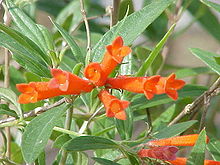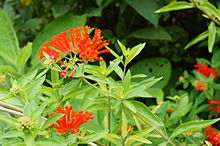
Bouvardia is a genus of flowering plants in the family Rubiaceae. It contains about 50 species of evergreen herbs and shrubs native to Mexico and Central America, with one species extending into the southwestern United States. The genus is named in honor of Charles Bouvard (1572–1658), physician to Louis XIII, and superintendent of the Jardin du Roi in Paris.

Balmea is a monospecific genus of flowering plants in the family Rubiaceae containing the single species Balmea stormiae. It is native to El Salvador, Guatemala and Mexico. It is locally known as ayuque. It is conical in shape and used as a Christmas tree in parts of Mexico. Because populations are depleted by this overharvest, this species is threatened with extinction.
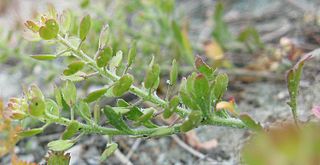
Lepidium oblongum is a widespread North American species of flowering plant in the mustard family known by the common name veiny pepperweed. It is native to Mexico, Guatemala, El Salvador, and the western and south-central United States. It is present as an introduced species in Hawaii. It can grow in many types of habitats.
Cephalanthus salicifolius is a species of flowering plant in the family Rubiaceae. Common names include Mexican buttonbush, mimbre, botoncillo, and Jazmin blanco. Its native range extends from the banks of the southernmost stretch of the Rio Grande in Cameron and Hidalgo Counties of Texas through much of Mexico from Coahuila to Oaxaca; a disjunct population exists in Honduras.

Gymnosperma is a genus of North American flowering plants in the family Asteraceae.

Crusea is a genus of angiosperms in the family Rubiaceae. The genus is found in the south-western United States, Mexico, and Central America. A few species are naturalized in Cuba and Puerto Rico.
Prionosciadium thapsoides is a plant species native to the States of Veracruz and México, in the República de México, as well as Guatemala.
Prionosciadium humile is a species native to the Mexican state of Nuevo León. It is a biennial herb with trifoliate leaves, each leaflet palmately 3-lobed and almost cleft.
Prionosciadium nelsonii is a plant species known from the Mexican states of Chiapas and Morelos. It is a biennial herb with a large taproot. Leaves are compound with narrowly lanecolate leaflets, some of them with narrow, tapering lobes. The inflorescence is a compound umbel at the top of the stem.
Trixis inula, the tropical threefold, is a plant species native to Texas, Mexico, Central America, northern South America, and the West Indies. It is found on open, sandy sites such as roadsides, thorn scrub, thickets, etc.

Celtis ehrenbergiana, called the desert hackberry or spiny hackberry, is a plant species that has long been called C. pallida by many authors, including in the "Flora of North America" database. It is native to Arizona, Florida, New Mexico and Texas, and to Latin America as far south as central Argentina. It grows in dry locations such as deserts, brushlands, canyons, mesas and grasslands.

Ardisia escallonioides, the Island marlberry, is a plant species native to the West Indies and neighboring areas. It has been reported from Barbados, Bermuda, the Dominican Republic, Cuba, Mexico, Belize, Guatemala and Florida.
Calycolpus warscewiczianus is a plant species native to Nicaragua, Costa Rica, Panamá and Venezuela.
Persea brevipetiolata is a plant species known from the Mexican States of Oaxaca and Veracruz. It is found in lowland forests in the Isthmus of Tehuantepec at elevations less than 250 m.
Galium orizabense is a species of plants in the family Rubiaceae, named for the town of Orizaba in Veracruz, where the first collections of the species were made. The species is native to Mexico, Costa Rica, Guatemala, Panamá, Venezuela, Colombia, and Hispaniola, plus widely scattered locations in the southeastern United States.
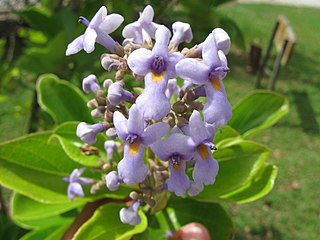
Cornutia is a genus of plants in the family Lamiaceae, first described in 1753. Species in this genus are native to tropical parts of the Western Hemisphere, including southern Mexico, Central America, the West Indies, and northern South America.
Rubus humistratus is a Mesoamerican species of flowering plants in the rose family. It widespread across much of Mexico and Central America from Nuevo León to Costa Rica.
Rubus schiedeanus is a Mesoamerican species of brambles in the rose family. It grows in southern Mexico and Central America.
Rubus vulcanicola is an uncommon Central American species of brambles in the rose family. It has been found only in Panamá and Costa Rica. The species was initially discovered on the sides of Volcán Poas in Costa Rica.
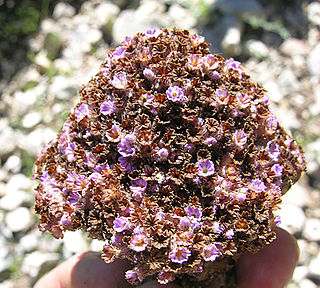
Lennoa is a monotypic genus of flowering plants belonging to the family Boraginaceae. It only contains one known species, Lennoa madreporoidesLex. It is within the subfamily of Lennoaceae.
